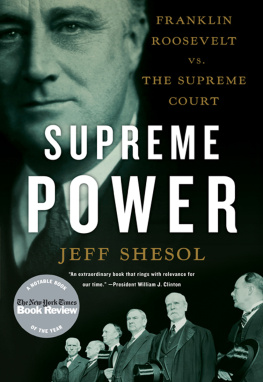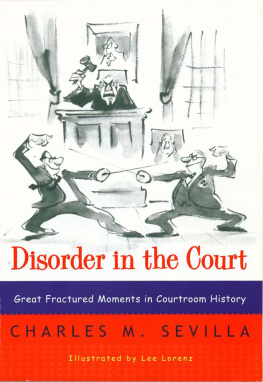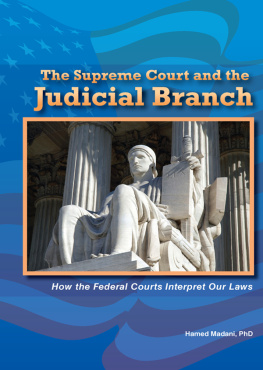First published in the UK in 2012 by
Intellect, The Mill, Parnall Road, Fishponds, Bristol, BS16 3JG, UK
First published in the USA in 2012 by
Intellect, The University of Chicago Press, 1427 E. 60th Street,
Chicago, IL 60637, USA
Copyright 2012 Intellect Ltd
All rights reserved. No part of this publication may be reproduced, stored in a retrieval system, or transmitted, in any form or by any means, electronic, mechanical, photocopying, recording, or otherwise, without written permission.
A catalogue record for this book is available from the
British Library.
Cover designer: Holly Rose
Copy-editor: MPS Technologies
Production manager: Bethan Ball
Typesetting: Planman Technologies
ISBN 978-1-84150-647-0
eISBN 978-1-84150-759-0
Printed and bound by Bell & Bain Ltd UK
Television courtroom broadcasting (TCB) is as hotly debated today as it was in the Estes case in the US Supreme Court in 1965. The same arguments and concerns that arose in 1965 exist today as they did then. For various reasons, the empirical research required to confirm and validate the respective effects which judges, policy makers and society have been concerned about has not been carried out.
It is unfortunate, therefore, that the debate surrounding television courtroom broadcasting still frequently rests upon hot air and personal opinions.
One of the central concerns in relation to television courtroom broadcasting is that television cameras or television operators will distract the various people who are required as part of the courtroom process. This includes witnesses, the jury, judges, lawyers and court staff.
This is the concern in relation to distraction effects. The empirical research effort since 1965 has been insufficient to answer and validate this concern. While there are some studies, these are too diminutive and stand alone. That is, they do not seek to verify or replicate each other. Each study, therefore, stands in splendid isolation.
Quite glaring research gaps exist in relation to our knowledge of the effects, adverse and positive, in relation to television courtroom broadcasting.
It might be suggested that because the actual size of television cameras has reduced so much, that there are no distraction effects. Some television courtroom broadcasting today does involve miniaturised television cameras. However, there is no research or statistics to show that this is universally or even predominantly the case.
There is also no research to compare the effects between situations where full sized versus miniaturised television cameras are used.
While media technology has changed, the significant point is that the research technology has also changed. Today, we have more research technology, research tools and comparative research knowledge than at any time previously.
We are better able to research distraction effects today than we were in 1965. Just because certain television courtroom broadcasting now involves miniaturised cameras, does not mean that distraction cannot occur. Indeed, even without actual distraction effects, there may still be other inhibiting effects, particularly on the non-professional persons whom may be in court.
One of the ways to conduct research in relation to where a person is looking involves new research tools called eye-trackers. An eye-tracker involves very small cameras which record where a persons eyes are looking. The result is a recorded video showing exactly where and for how long the person is looking.
If applied to the problem of distraction effects in the courtroom, we can now record and see where the individual courtroom participants are looking. We can see if they are distracted by the television cameras or the camera operator in the courtroom. We can also apply eye-tracking research to different types of television cameras in courtrooms, from small to large, from fixed to moving cameras.
We shall explore the first proof of concept demonstration of eye-tracking inside a courtroom with a view to examining television courtroom broadcasting distraction effects. Many of the eye-tracking images and topography are reproduced, as well as the implications discussed.
We can now research actual distraction effects in the television courtroom broadcasting debate.
Social scientists measure the intelligence of monkeys more effectively than courts have attempted to ascertain the effects of television in the courtroom.
(Hirschhorn 1980: 7 and 9)
Television courtroom broadcasting arguments and the effects research are each inadequate. We have not devoted sufficiently rigorous and empirical research to the effects. The in-court distraction effects of television cameras, or television cameras plus operators, on the courtroom participants/actors in the courtroom are unknown. The US Supreme Court, in the three television courtroom broadcasting cases, has set a challenge to carry out more empirical effects-research.
New technology can now accurately track and record whether the courtroom participants/actors (real or mock courtroom participants/actors) look at the television cameras in the courtroom and for how long. We can now for the first time accurately research in-court distraction effects. This new technology is called eye-tracking technology. The author has undertaken the first demonstration of the use of eye-tracking to examine in-court distraction effects for television courtroom broadcasting.
The publication of this book is kindly assisted by a grant from the National University of Ireland.
Debate and concerns
Cameras in court or television courtroom broadcasting (TCB) is topical and controversial. This book explores one important aspect of the TCB debate.
It explores one of the central concerns in the TCB debate, namely whether there are effects of television cameras in the courtroom. Are the people in court affected or distracted by the television cameras? This is a frequent concern in the debate regarding TCB. Many people have argued that TCB will adversely affect or distract the participants in a case where cameras are permitted. This concern extends to the camera operators if they are permitted in the courtroom.
We will see that not only do these concerns remain, but that they have never been properly researched empirically. With that in mind, the author identifies how modern technology may afford a solution to this part of the wider debate regarding TCB effects.
Eye-tracking can track and record where individual persons in the courtroom are looking, for how long and ultimately whether they are distracted. Eye-tracking TCB research can provide valuable data, insights and answers, which have lingered at least since 1965 when the US Supreme Court first voiced its concerns. (The US Supreme Court shall generally be referred to as the Supreme Court throughout the rest of the book).
The book also points out that the debate and effects research need to be much more nuanced.
The legal starting point is the Supreme Court cases. The Supreme Court refers to the distraction-research issues and concerns. It sets the Supreme Court distraction effects research-challenge. The Supreme Court distraction effects research-challenge is significant internationally.








